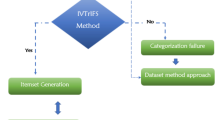Abstract
Interval methods is one option for managing uncertainty in optimization problems and in decision management. The precise numerical estimation of coefficients may be meaningless in real-world applications, because data sources are often uncertain, vague and incomplete. In this paper we introduce a comparison index for interval ordering based on the generalized Hukuhara difference; we show that the new index includes the commonly used order relations proposed in literature. The definition of a risk measure guarantees the possibility to quantify a worst-case loss when solving maximization or minimization problems with intervals.





Similar content being viewed by others
References
Bellman RE, Zadeh LA (1970) Decision-making in a fuzzy environment. Manag Sci 17(4):141–164
Chalco-Cano Y, Román-Flores H, Jiménez-Gamero MD (2011) Generalized derivative and π-derivative for set-valued functions. Inf Sci 181(11):2177–2188. doi:10.1016/j.ins.2011.01.023
Dantzig GB (1963) Linear programming and extensions. Princeton University Press, Princeton
Dubois D (2010) Representation, propagation, and decision issues in risk analysis under incomplete probabilistic information. Risk Anal 30(3):361–368
Dubois D, Prade H (1980) Fuzzy sets and systems: theory and applications. Academic Press, New York
Dubois, D, Prade, H (eds) (2000) Fundamentals of fuzzy sets. The handbooks of fuzzy sets series. Kluwer, Boston
Guerra ML, Stefanini L (2011) A comparison index for interval ordering. IEEE SSCI 2011, symposium series on computational intelligence (FOCI 2011), pp 53–58
Inuiguchi M, Ramik J (2000) Possibilistic linear programming: a brief review of fuzzy mathematical programming and a comparison with stochastic programming in portfolio selection problem. Fuzzy Sets Syst 111:3–28
Ishibuchi H, Tanaka H (1990) Multiobjective programming in optimization of the interval objective function. Eur J Oper Res 48:219–225
Jiang C, Han X, Liu GR, Liu GP (2008) A nonlinear interval number programming method for uncertain optimization problems. Eur J Oper Res 188:1–13
Kaburlasos VG (2006) Towards a unified modelling and knowledge-representation based on lattice theory. Springer, Berlin
Kehagias A (2011) Some remarks on the lattice of fuzzy intervals. Inf Sci 181(10):1863–1873
Markov S (1977) A non-standard subtraction of intervals. Serdica 3:359–370
Markov S (1979) Calculus for interval functions of a real variable. Computing 22:325–337
Moore RE (1979) Methods and applications of interval analysis. Society for Industrial and Applied Mathematics, Philadelphia
Moore RE, Kearfott RB, Cloud MJ (2009) Introduction to interval analysis. Society for Industrial and Applied Mathematics, Philadelphia
Negoita CV, Ralescu D (1975) Applications of fuzzy sets to systems analysis. Birkhauser, Basel
Oliveira C, Henggeler Antunes C (2007) Multiple objective linear programming models with interval coefficients—an illustrated overview. Eur J Oper Res 181:1434–1463
Papadakis SE, Kaburlasos VG (2010) Piecewise-linear approximation of nonlinear models based on probabilistically/possibilistically interpreted intervals’ Numbers (INs). Inf Sci 180(24):5060–5076
Plotnikova NV (2005) Systems of linear differential equations with p-derivative and linear differential inclusions. Sbornik: Math 196:1677–1691
Ramik J (2007) Optimal solutions in optimization problem with objective function depending on fuzzy parameters. Fuzzy Sets Syst 158(11):1873–1881
Sengupta A, Pal TK (2000) On comparing interval numbers. Eur J Oper Res 127:28–43
Sengupta A, Pal TK (2009) Fuzzy preference ordering of interval numbers in decision problems. Springer, Berlin
Stefanini L (2010) A generalization of Hukuhara difference and division for interval and fuzzy arithmetic. Fuzzy Sets Syst 161(11):1564–1584
Tanaka H, Okuda T, Asai K (1974) On fuzzy mathematical programming. J Cybern 3:37–46
Tong S (1994) Interval number and fuzzy number linear programming. Fuzzy Sets Syst 66:301–306
Wang X, Kerre EE (2001a) Reasonable properties for the ordering of fuzzy quantities (I). Fuzzy Sets Syst 118:375–385
Wang X, Kerre EE (2001b) Reasonable properties for the ordering of fuzzy quantities (II). Fuzzy Sets Syst 118:387–405
Zadeh LA (1965) Fuzzy sets. Inf Control 8:338–353
Zimmermann HJ (1987) Fuzzy sets, decision making and expert systems. Kluwer, Boston
Acknowledgments
This research was partially supported by the National Project PRIN (2008JN-WWBP_004): Models and Fuzzy Calculus for Economic and Financial Decisions, financed by the Italian Ministry of University.
Author information
Authors and Affiliations
Corresponding author
Rights and permissions
About this article
Cite this article
Guerra, M.L., Stefanini, L. A comparison index for interval ordering based on generalized Hukuhara difference. Soft Comput 16, 1931–1943 (2012). https://doi.org/10.1007/s00500-012-0866-9
Published:
Issue Date:
DOI: https://doi.org/10.1007/s00500-012-0866-9




